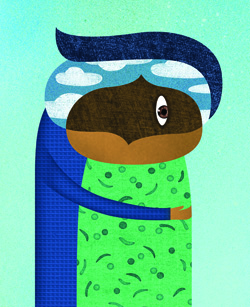Kids with sickle cell disease (SCD) grow up facing a future of potential organ damage, vision problems, infections, and stroke. But perhaps the most agonizing part of living with the disease is dealing with the “crises”—unpredictable attacks of intense pain that take over little bodies, often sending them to a hospital for narcotics to curb the pain. But getting treatment can be tough. “When I go to the ER, I often see a doctor not willing to give me the amount of medicine that will help me get out of pain,” says Jasmine Llewellyn, a 24-year-old SCD patient who was diagnosed at 9 months. “And to deal with the stress of that on top of the pain just makes it worse.”
“There is a big disconnect between what providers believe and what patients actually experience,” adds Carlton Haywood Jr., SPH ’09 (PhD), an assistant professor in the School of Medicine who himself lives with SCD. At the onset of symptoms—acute swelling of the hands and feet that begins around 6 months of age—doctors and nurses focus on helping the baby. But as the child ages, there are fewer such visible symptoms and no objective measure of pain, and providers, who must rely on patients asking for specific and large doses of narcotics, often suspect that patients are exaggerating or lying to get access to the drugs.
SCD, a genetic disorder in which misshapen red blood cells restrict blood flow and deprive the body of sufficient oxygen levels, affects as many as 100,000 Americans, primarily African Americans. Thirty years ago, most people with SCD did not live past childhood. Now that advanced treatment options allow these patients to live into their 40s, relieving their suffering and improving their quality of life is that much more important. “We need to focus on improving the continuum of care [from childhood to adulthood] and improving the quality of life to help people live well every day,” says Cynda Rushton, associate professor at the Johns Hopkins School of Nursing.
Rushton and Haywood, along with Mary Catherine Beach, SPH ’99, ’02 (PDF), and Gail Geller, SPH ’79, ’89 (ScD), recently received a $1 million, two-year, elite Challenge Grant from the National Institutes of Health to develop a training program to integrate palliative care—a medical specialty focused on relieving pain and symptoms and improving overall quality of life for patients with serious illnesses—into the treatment of children with SCD and Duchenne muscular dystrophy. (Duchenne MD, which affects only boys, is another chronic, inherited, life-threatening illness.)
The researchers—all members of the core faculty at the Berman Institute of Bioethics—combined efforts after the institute’s board meeting in February 2009. Haywood had teamed up with Beach, a physician and associate professor at the School of Medicine who holds a joint appointment at the Bloomberg School, to develop videos featuring SCD patients explaining their struggles to get proper care. At the meeting, they learned that Rushton and Geller, a professor of medicine at the School of Medicine with a joint appointment at the Bloomberg School, were developing a curriculum to train clinicians in providing palliative care to children with life-threatening neuromuscular diseases, including Duchenne MD. “We had this aha experience and realized we could combine forces,” Haywood remembers.
They spent the first year of the grant developing a series of nine videos on different aspects of palliative care, including transitioning from child to adult care and gaining the trust of patients. They plan to use the curricula they develop with the videos for training programs now undergoing testing at nine U.S. hospitals. In addition to alleviating discomfort, the researchers hope their training will lead to patients and their parents being more involved in making decisions about their care. Geller cites a surgery that boys with Duchenne MD get around age 14. The surgery fuses the spine so that they can sit up straight and breathe, but they also lose their ability to bend forward, and the surgery can cause chronic pain. “Clinicians tend to emphasize the benefits of the surgery, but what we hear from families is that they really had no idea there would be such a loss of function,” says Geller. “They don’t allow families to think about what kind of life they want to live for however many years the patient has left.”
The videos also attend to the emotional well-being of the patient. “One of our videos focuses on hope,” says Geller. “When hope for a cure is the only form of hope, it can be devastating for families because every year they hear about some discovery that is 25 years off, or that fails, and it becomes a roller-coaster ride. One contribution of palliative care is other things to hope for, to hope for a good day or to have meaning in life. That’s a major goal for our project.”

